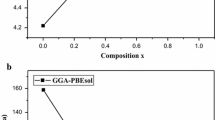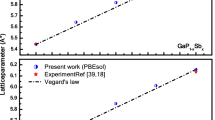Abstract
Superconductivity in ternary metallic glasses has been investigated using the model pseudopotential approach, which has been found quite successful in explaining superconductivity in metals, binary alloys and binary glasses. It is observed that this simple methodology successfully explains superconducting behaviour of ternary glasses without requiring the solution of Dirac equation for a many body problem or estimation of various interactions as required in ab-initio pseudopotential theory. In the present work superconducting state parameters of fourteen metallic glasses of (Ni-Zr)-M system (M=Ti, V, Co, Cu) have been determined in the BCS-Eliashberg-McMillan framework. It is observed that addition of V, Co, and Cu as the third element (M) to a binary metallic glass (Ni33 Zr67) causes the parameters λ,T c, α, andN 0 V to decrease, and Coulomb pseudopotential (μ*) to increase with concentration of M, showing that the presence of third element (M) causes suppression of superconducting behaviour of the alloy. The decrease inT c with increasing concentration of third element (M) may be attributed to the modifications in density of states at the Fermi levelN(E F), and probable changes in the band structure of the alloy due to addition of the third element (M). Slight difference is noticed when Ti is added to the Ni33 Zr67 alloy. In this caseT c rises initially and then decreases with concentration of M, showing a peak at aboutx=0.05. This indicates that on addition of Ti, 3d states grow near the Fermi level and hence contribute substantially toN(E F), favouring superconducting behaviour in this case. The present results forT c show an excellent agreement with the experimental data. QuadraticT c equations have been proposed, which provide successfully theT c values of ternary metallic glasses under consideration.
Similar content being viewed by others
References
U. Mizutani, C. Mishima, and T. Goto: J. Phys.: Cond. Matter1 (1989) 1831.
Y. Yamada, Y. Itoh, and U. Mizutani: Mater. Sci. Engg.99 (1988) 289.
R. Zehringer, P. Oelhafen, H.-J. Guntherodt, Y. Yamada, and U. Mizutani: Mater. Sci. Engg.99 (1988) 317.
U. Mizutani, Y. Yamada, and C. Mishima: Solid State Commun.62 (1987) 641.
R. Sharma and K.S. Sharma: Supercond. Sci. Technol.10 (1997) 557.
K.S. Sharma and C.M. Kachhava: Czech. J. Phys. B.30 (1980) 619.
R. Sharma and K.S. Sharma: Czech. J. Phys. B24 (1984) 325.
R. Sharma, K.S. Sharma, and L. Dass: Czech. J. Phys. B39 (1989) 537.
N.S. Saxena, K.C. Jain, N. Gupta, and M.P. Saxena: Physica174 (1991) 136.
M. Gupta, P.C. Agarwal, K.S. Sharma, and L. Dass: Phys. Status Solidi B211 (1999) 731.
S. Sharma and H. Khan: inProc. of DAE Solid State Physics Symp., Jiwaji University, Gwalior, 2003, Abstract hP 26, Manuscript No. 326.
S. Sharma, K.S. Sharma, and H. Khan: Supercond. Sci. Technol.17 (2004) 474.
S. Sharma, H. Khan, and K.S. Sharma: Phys. Status Solidi B241 (2004) 2562.
N.W. Ashcroft: Phys. Lett.23 (1966) 48.
M. Gellmann and K.A. Brueckner: Phys. Rev.106 (1958) 364.
G. Grimvall:Thermodynamic properties of Materials, Amsterdam, North Holland, 1986, p. 49.
C.M. Varma and R.C. Dynes: inSuperconductivity in d- and f-band metals, (Ed. D.H. Douglass), Plenum Press, New York, 1976, p. 507.
P.B. Allen and R.C. Dynes: Phys. Rev. B12 (1975) 905.
H.P.R. Frederiske (ed.): inAmerican Inst. of Phys. Handbook (3rd edn.), McGraw Hill, New York.
P. Morel and P.W. Anderson: Phys. Rev.125 (1962) 1263.
J. Emsley: inThe Elements (3rd edn.), Oxford Univ. Press, Oxford, 1998.
C.V. Pandya, P.R. Vyas, T.C. Pandya, N. Rani, and V.B. Gohel: Physica B307 (2001) 138.
C. Kittel:Introduction to Solid State Physics (7th edn.), Wiley, New York, 1996.
P.B. Allen and M.L. Cohen: Phys. Rev.187 (1969) 525.
W.L. McMillan: Phys. Rev.167 (1968) 331.
Author information
Authors and Affiliations
Corresponding author
Rights and permissions
About this article
Cite this article
Sharma, S., Khan, H. & Sharma, K.S. A pseudopotential approach to the superconducting state parameters of (Ni33Zr67)1−x M x (M=Ti, V, Co, Cu) ternary metallic glasses. Czech J Phys 55, 1005–1011 (2005). https://doi.org/10.1007/s10582-005-0099-6
Received:
Accepted:
Issue Date:
DOI: https://doi.org/10.1007/s10582-005-0099-6




